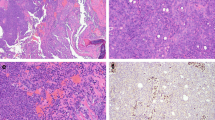Abstract
SMARCB1/INI1 deficient sinonasal carcinoma is a variant of sinonasal undifferentiated carcinoma (SNUC). There is a paucity of literature describing the histomorphological features of this relatively new entity. Herein we describe the histomorphological features of three such cases and review the literature. We retrospectively reviewed the cases of SNUC diagnosed in our institute in the last 6 years. Immunohistochemistry for INI1, NUT & p16 were performed on these cases. Three cases showed loss of INI1. The histomorphology and clinicopathological features of these cases were studied and compared with non INI1 deficient SNUC. A total of 9 cases of SNUC were identified. Three of these cases showed loss of INI1. These three cases had presented with large sinonasal mass and with intracranial extension. Histopathology of these cases showed a diffuse infiltrative pattern, nest, and islands of predominantly basaloid cells with focal rhabdoid morphology. Additional features like small cell carcinoma like pattern, pseudoalveolar and pseudoglandular patterns, clear vacuoles and pseudopapillary appearance were also noted. We conclude that in presence of a mixed pattern of cells with a predominance of basaloid morphology, the possibility of SMARCB1/INI1 deficient sinonasal carcinoma must be strongly suspected and immunohistochemistry for INI1 must be performed.





Similar content being viewed by others
References
El-Naggar AK, Chan JK, Grandis JR, Takata T, Slootweg PJ. WHO classification of head and neck tumours, vol. 9, 4th ed. Lyon: IARC Press; 2017.
Stelow EB, Bellizzi AM, Taneja K, et al. NUT rearrangement in undifferentiated carcinomas of the upper aerodigestive tract. Am J Surg Pathol. 2008;32:828–34.
Agaimy A, Hartmann A, Antonescu CR, et al. SMARCB1 (INI-1)–deficient sinonasal carcinoma: a series of 39 cases expanding the morphologic and clinicopathologic spectrum of a recently described entity. Am J Surg Pathol. 2017;41:458–71.
Agaimy A, Weichert W. SMARCA4-deficient sinonasal carcinoma. Head Neck Pathol. 2017;11:541–5.
Agaimy A, Koch M, Lell M, et al. SMARCB1(INI1)-deficient sinonasal basaloid carcinoma: a novel member of the expanding family of SMARCB1-deficient neoplasms. Am J Surg Pathol. 2014;38:1274–81.
Bishop JA, Antonescu CR, Westra WH. SMARCB1 (INI-1)-deficient carcinomas of the sinonasal tract. Am J Surg Pathol. 2014;38:1282–9.
Bell D, Hanna EY, Agaimy A, Weissferdt A. Reappraisal of sinonasal undifferentiated carcinoma: SMARCB1 (INI1)-deficient sinonasal carcinoma: a single-institution experience. Virchows Arch. 2015;467:649–56.
Zeng M, Chen C, Yang S, Chen X. SMARCB1 (INI1)-deficient sinonasal carcinoma: a newly described entity. Int J Clin Exp Pathol. 2016;9:3454–8.
Shatzkes DR, Ginsberg LE, Wong M, et al. Imaging appearance of SMARCB1 (INI1)-deficient sinonasal carcinoma: a newly described sinonasal malignancy. AJNR Am J Neuroradiol. 2016;37:1925–9.
Wasserman JK, Dickson BC, Perez-Ordonez B, et al. INI1 (SMARCB1)-deficient sinonasal carcinoma: a clinicopathologic report of 2 cases. Head Neck Pathol. 2017;11:256–61.
Kakkar A, Antony VM, Pramanik R, Sakthivel P, Singh CA, Jain D. SMARCB1 (INI1)-deficient sinonasal carcinoma: a series of thirteen cases with assessment of histological patterns. Hum Pathol. 2019;83:59–67.
Trieu V, Aulet RM, Ciolino A, Rimash T. SMARCB1-deficient sinonasal carcinoma: a case report and discussion of the clinical implications. Ann Otol Rhinol Laryngol. 2019;128:676–80.
Fard EV, Zhang S, Cai Z, et al. Sinonasal undifferentiated carcinoma: clinicopathological spectrums and diagnosis reappraisal. Hum Pathol. 2019;89:62–70.
El-Mofty SK, Lu DW. Prevalence of high-risk human papillomavirus DNA in nonkeratinizing (cylindrical cell) carcinoma of the sinonasal tract: a distinct clinicopathologic and molecular disease entity. Am J Surg Pathol. 2005;29:1367–72.
Wadsworth B, Bumpous JM, Martin AW, Nowacki MR, Jenson AB, Farghaly H. Expression of p16 in sinonasal undifferentiated carcinoma (SNUC) without associated human papillomavirus (HPV). Head Neck Pathol. 2011;5:349–54.
Gray ST, Herr MW, Sethi RK, et al. Treatment outcomes and prognostic factors, including human papillomavirus, for sinonasal undifferentiated carcinoma: a retrospective review. Head Neck. 2015;37:366–74.
Agaimy A, Jain D, Uddin N, Rooper LM, Bishop JA. SMARCA4-deficient sinonasal carcinoma: A series of 10 cases expanding the genetic spectrum of SW1/SNF-driven sinonasal malignancies. Am J Surg Pathol. 2020;44:703–10.
Kohashi K, Oda Y. Oncogenic roles of SMARCB1/INI1 and its deficient tumors. Cancer Sci. 2017;108:547–52.
Kohashi K, Oda Y, Yamamoto H, et al. Highly aggressive behaviour of malignant rhabdoid tumor: a special reference to SMARCB1/INI1 gene alterations using molecular genetic analysis including quantitative real-time PCR. J Cancer Res Clin Oncol. 2007;133:817–24.
Versteege I, Medjkane S, Rouillard D, Delattre O. A key role of the hSNF5/INI1 tumour suppressor in the control of the G1-S transition of the cell cycle. Oncogene. 2002;21:6403–12.
Betz BL, Strobeck MW, Reisman DN, Knudsen ES, Weissman BE. Re-expression of hSNF5/INI1/BAF47 in pediatric tumor cells leads to G1 arrest associated with induction of p16ink4a and activation of RB. Oncogene. 2002;21:5193–203.
Funding
This study did not receive any funding.
Author information
Authors and Affiliations
Contributions
PA: Data curation, investigation, visualization, project administration, writing—review and editing. PM: Conceptualization, Data curation, methodology, formal analysis, and writing—original draft, review and editing. CP: Conceptualization, Data curation, investigation, visualization, project administration, writing—review and editing. AKA: Conceptualization, Data curation, methodology, formal analysis, and writing—original draft, review and editing.
Corresponding author
Ethics declarations
Conflict of interest
The authors declare that they have no conflict of interest.
Ethical Approval
Ethical approval was waived by the local Ethics Committee of All India Institute of Medical sciences Bhubaneswar, in view of the retrospective nature of the study and all the procedures being performed were part of the routine care.
Additional information
Publisher's Note
Springer Nature remains neutral with regard to jurisdictional claims in published maps and institutional affiliations.
Electronic supplementary material
Below is the link to the electronic supplementary material.
Rights and permissions
About this article
Cite this article
Ayyanar, P., Mishra, P., Preetam, C. et al. SMARCB1/INI1 Deficient Sino-Nasal Carcinoma: Extending the Histomorphological Features. Head and Neck Pathol 15, 555–565 (2021). https://doi.org/10.1007/s12105-020-01246-9
Received:
Revised:
Accepted:
Published:
Issue Date:
DOI: https://doi.org/10.1007/s12105-020-01246-9




